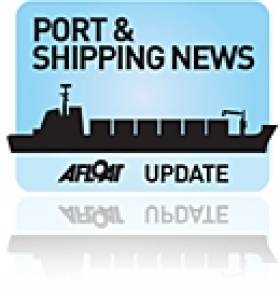Displaying items by tag: SSGairsoppa
Ports & Shipping Review: Port Trade Rise,Silver-Salvage, Ports Study, Ferries, 'Olympic' Cruiseships and New Ship
#PORTS & SHIPPING REVIEW - Over the last fortnight Jehan Ashmore has reported from the Ports & Shipping Scene which saw trade volumes in Drogheda Port continue to rise. An increase of over 44% was recorded for the first six months of 2012 compared to the same period last year.
Off the west coast, a record breaking 48 tonnes of silver bullion has been recovered from the wreck of S.S. Gairsoppa, a 412-ft British cargoship that was torpedoed by U-Boat in WWII.
The Competition Authority is to conduct an in depth review of how our ports perform and how they are to be funded and to examine whether Dublin Port has an economically dominant position.
A boost on all fronts for traffic figures on Stena Line's Belfast-Birkenhead (Liverpool) route was welcomed by the ferry operator which completed the takeover of operations from DFDS Seaways last summer.
Single-route operator Celtic Link Ferries reached an agreement with Rosslare Europort, to end a stalemate in over €100,000 relating to unpaid port landing fees.
Deutschland, one of the three cruiseships that visited Dublin Port last weekend completed its cruise in London, where the vessel is currently moored as a floating hotel for the German Olympic Sports Federation.
Belfast M.P. Nigel Dodds is leading a campaign to keep the WWI battleship cruiser HMS Caroline, the last survivor of the Battle of Jutland, from leaving the city. The 1914 built ship could be moved to Portsmouth for preservation or even face scrapping.
At the other end of the island, Cork based Irish Mainport Holdings has acquired a new seismic-support ship. The vessel renamed Mainport Kells has recently taken up a long-term charter contract for clients operating in the North Sea.
Huge Haul of Silver Salvaged from WW2 Wreck off Galway
#SHIP'S SILVER SALVAGE – A record breaking 48 tonnes of silver bullion has been recovered from S.S. Gairsoppa, a 412-ft British cargoship that was torpedoed by U-Boat in WWII and sank some 300 miles south-west of the Galway coast in 1941.
The salvage operation was carried out by Odyssey Marine Exploration, in depths of three-miles, where the hoard of 1,203 bars or approximately 1.4 million troy ounces of silver was retrieved.
According to the US based company it is the heaviest and deepest recovery of precious metals salvaged from a shipwreck, which was undertaken by chartering the Seabed Worker.
The wreck of S.S. Gairsoppa lies in international waters at 4,700m and was firstly discovered using sonar by the chartered Russian research vessel RV Yuzhmorgeologiya and followed by visual inspection by a remotely operated vehicle (ROV) from the Odyssey Explorer.
During the War, the UK Government insured privately owned cargo under their War Risk Insurance program. After making an insurance payment of approximately £325,000 (1941 value) to the owners of the silver cargo lost aboard the Gairsoppa, the UK Government became the owners of the insured cargo.
As some sources, including "Lloyd's War Losses" indicate a total silver cargo worth £600,000 (1941 value) lost aboard the Gairsoppa, there may have been additional government-owned silver cargo aboard that would have been self-insured.
After unloading the precious cargo from the salvage-ship, the cargo was located in a secure facility in the UK. Odyssey claim that the amount of silver bars recovered so far represents approximately 43% of the insured silver bars, or approximately 20% of the total silver cargo which research has indicated may be on board.
The salvage-ship was to take on fuel and change of personnel, where recovery operations will continue back at the wreck of S.S. Gairsoppa and are expected to be completed in the third quarter of 2012.
In addition, an estimated 600,000 oz. of insured silver is expected to be found on S.S. Mantola, another shipwreck recovery project being conducted in conjunction with the Gairsoppa project.
Odyssey is conducting the Gairsoppa project under contract with the UK Department for Transport. Under the terms of the agreement, which follows standard commercial practices, Odyssey bears the risk of search and recovery and retains 80% of the net salved value of the ship's silver cargo after recovering its expenses.

























































